How to Avoid Problems with Growing Medium Compaction


Growing media serve four functions: plant support, water retention, reservoir for nutrients, and exchange of gases.
All growing media are engineered to achieve these functions to produce high-quality plants. These functions vary depending on the origin of the substrate/components, particle size, and container shape and height. Nevertheless, most growing medium manufacturers can provide customers with Technical Data Sheets that list the physical properties, nutrient content and other product information about a specific growing medium.
Compaction changes the physical properties of the growing medium, defeating the purpose of having the proper growing medium for a particular crop or application.
This article will cover the negative effects of growing medium compaction and how to avoid it.
What Causes the Compaction of Growing Media
Growing medium compaction is a common problem in greenhouses and nurseries. Compaction occurs when a force is applied to the surface of the growing medium or even by the weight of the growing medium itself causing the mix volume to decrease. A clear example is the use of sand as a component of the growing medium; sand is heavier than most growing medium components, hence the bottom section of the pot will have to support the weight of the sand plus the weight of the water.
Macropores within a growing medium are responsible for providing air space, fast water infiltration and good drainage. When compaction occurs, these macropores collapse and the physical structure is modified. Substrate compaction can also occur when the substrate has an improper ratio of coarse and fine particles, which can occur with the same component or with different components. This mistake is usually associated with a lack of availability of quality materials or a bad assumption that adding large-sized components to small components will correct physical properties.
Problems Associated with Compaction
It is easy to avoid compaction, but once it occurs, it is difficult to fix this problem. Listed below are the most common problems associated with growing medium compaction:
- Bulk density increases, and therefore, the weight of the pot increases.
- Total porosity and the air space decrease because the space occupied by the macropores is occupied by solids.
- Gas exchange is reduced.
- Poor infiltration, and runoff increase.
- Poor drainage which leads to waterlogging.
- The time to dry out increases.
- The percentage of unavailable water increases because the water is more tightly bound to the particles. In other words, capillarity increases.
- Roots have to work harder to get water.
- Water and fertilizers are obtained less efficiently.
- Fertilizer salts in the growing medium solution may become more concentrated, causing EC to increase.
- Roots have to use more force to penetrate the substrate, reducing the plants' energy reserves for growth and development.
- Plants may be stunted.
- Roots are shallower and short.
- Root distribution decreases and roots grow in sections of the pot.
- Compaction in some parts of the pot results in uneven root growth and water content.
- Natural organisms like mycorrhizal fungus can be damaged due to the unsuitable environment to live.
Milks et al. 1989 showed the effects of the physical properties at different compaction levels and with different pot sizes. They demonstrated that by increasing the compaction level, the % of solids, bulk density, and the % of unavailable water increased. In contrast, available water, air space and total porosity decreased. In addition, they showed that growing medium compaction is worse in short pots.
A common mistake often made by workers is when prefilled pots are stacked and nested inside each other for later transplanting (Figure 1 and Figure 2). The pot at the bottom of the stack supports the weight of all pots above, so the growing medium in the bottom pot will have a higher bulk density and lower air porosity and will dry out slowly after watering and retain more water than the pots on top. Moreover, when the substrate is compacted, the pot is going to require more growing medium to be filled and the workers will have to carry heavier pots.


Tips to avoid growing medium compaction:
- When the pots are prefilled, stacked and stored, it is necessary to have a physical barrier between layers of pots.
- Another option is to offset each layer of the pots so they do not nest inside each other.
- Avoid watering plants with a hose at high pressure.
- Minimize handling of the growing medium and containers.
- Fill the pots by gravity. This is essential when filling seedling trays.
- When transplanting, place the plug/cutting into dibble hole and water in. Do not press down the growing medium around the young plant.
- When manually making dibble holes in pots, the pressure applied to the growing medium will not be the same all the time and each worker will apply different pressure.
When fluffing bales/mixing media:
- Use machines with slow-turning ribbons/paddles.
- Minimize the time of mixing.
- Add moderate moisture.
Excessive fluffing/mixing can cause:
- Destruction of peat and other aggregates.
- It creates fine particles.
- Reduction of porosity and drainage.
- The growing medium dries out slowly.
In summary, compaction carries a large number of problems including alteration of the physical properties. The result of compaction is variability in crops and poor quality. Nevertheless, there are different levels of compaction, but the more heavily compacted the growing medium is, the poorer it will perform.
Remember there are many ways to avoid growing medium compaction but once it occurs, it is very difficult to fix the problem.
References:
Milks, R. R., W. C. Fonteno and R. A. Larson. 1989. Hydrology of Horticultural Substrates: III. Predicting Air and Water Content of Limited-volume Plug Cells. J. Amer. Soc. Hort. Sci. 114 (1): 57-61.